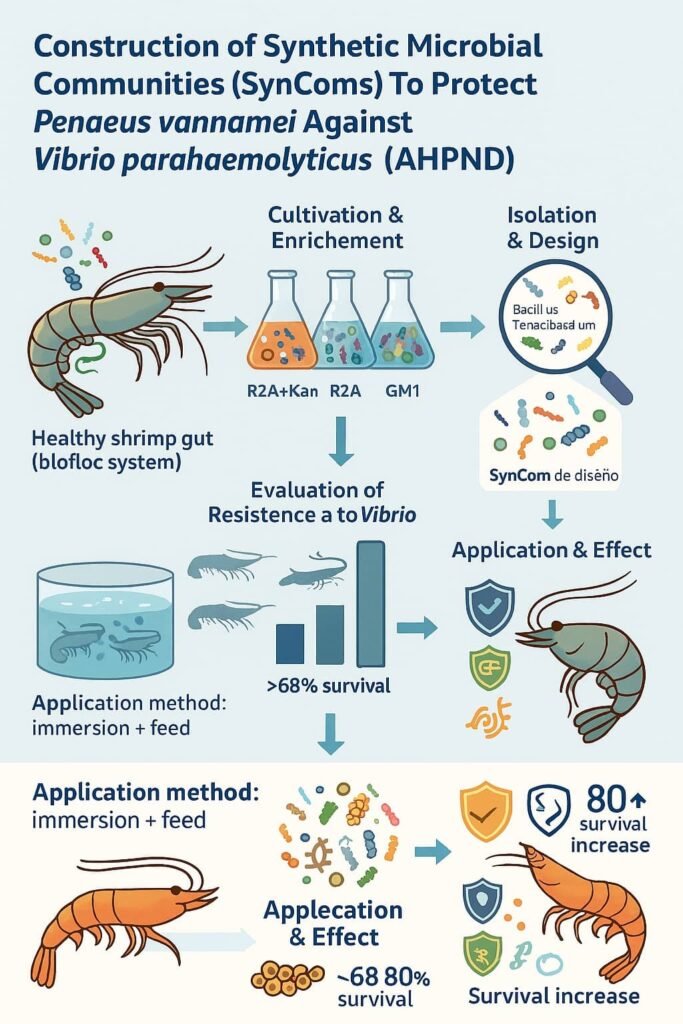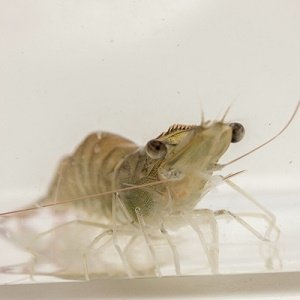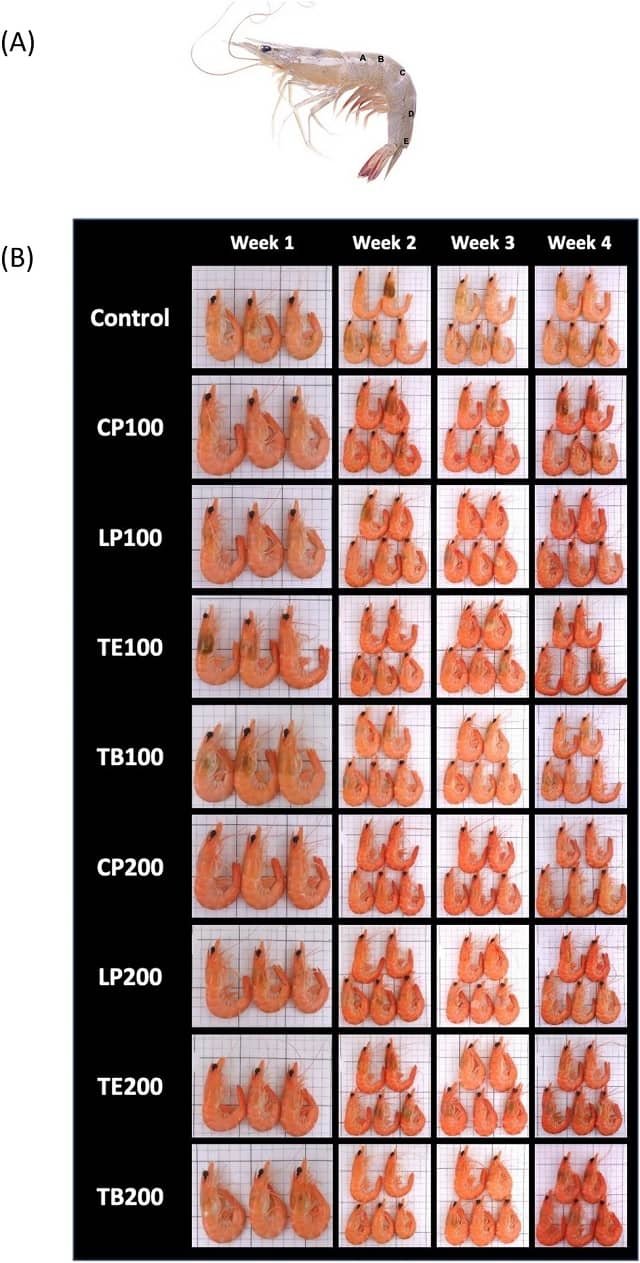
Vibriosis, particularly that caused by Vibrio parahaemolyticus, which leads to the devastating Acute Hepatopancreatic Necrosis Disease (AHPND), remains one of the greatest challenges for the global shrimp industry. For years, traditional responses have relied on water exchange and antibiotics; however, these practices are increasingly restricted due to their environmental impact and the development of antimicrobial resistance.
Probiotics have emerged as a promising alternative, albeit with limitations. Many commercial products are non-native to the aquaculture environment and have difficulty establishing themselves. Furthermore, scientific evidence suggests that bacterial consortia (‘teams’) are more stable and effective in combating pathogens than individual strains.
This has spurred interest in synthetic microbial communities (SynComs)—essentially ‘designer probiotics’ comprising multiple beneficial indigenous strains. The challenge, however, is that constructing them is a time-consuming and laborious process. A new study in Aquaculture from scientists at Ningbo University and the Zhejiang Institute of Freshwater Fisheries proposes an innovative, rapid strategy to identify, isolate, and assemble these highly effective SynComs.
Key conclusions
- 1 Key conclusions
- 2 The Origin: “Healthy” bacteria from the biofloc system
- 3 Why did they work? A look at the community
- 4 Optimizing application: Water, feed, or both?
- 5 From a consortium to a designed “SynCom”
- 6 The litmus test: Do the new SynComs work?
- 7 A resounding success: Overcoming the Vibrio challenge
- 8 Conclusions: A new strategy for aquaculture
- 9 Entradas relacionadas:
- Intestinal bacterial consortia, when enriched in specific media (R2A+Kan, R2A, GM1), improved shrimp resistance to Vibrio by over 68%.
- The most effective administration method was a combination of immersion (in water) and feed mixing (IM+MF), which improved post-challenge survival by 80.1%.
- Eight key strains were identified and isolated from the successful consortia, including genera such as Tenacibaculum, Bacillus, Ruegeria, Paracoccus, Microbacterium, and Exiguobacterium.
- The newly created “SynComs” (synthetic communities), particularly SynComAll (8 strains) and SynComR2A+Kan (6 strains), increased survival following the Vibrio challenge by up to 68.1%.
- The protective effect was associated with a heightened synergistic capacity to form biofilms and an increase in the shrimp’s digestive and immune enzymes (such as ACP and AKP).
The Origin: “Healthy” bacteria from the biofloc system
The researchers began with a promising source: the intestines of Penaeus vannamei shrimp raised in a biofloc system (BFS). Previous studies had already demonstrated that these shrimp were notably more resistant to Vibrio infections. The scientists collected the intestinal bacteria from these “healthy” shrimp to use as source material.
Finding the perfect enrichment “Recipe”
The first step was to culture these intestinal consortia in the laboratory. As not all bacteria grow equally, they tested eight different culture media “recipes” (R2A, R2A+Kan, R2A+Van, GM1, MRS, 1/2 2216E, RM, and LB). Once they had the eight enriched bacterial consortia, they were administered to shrimp postlarvae for six days. Subsequently, they evaluated two parameters: the shrimp’s “fitness” (survival and intestinal fullness) and, most importantly, their resistance after being deliberately infected with the pathogenic V. parahaemolyticus FX1 strain.
The winning (and losing) media
The results were clear: the culture medium matters significantly.
- The Winners: Consortia cultured in R2A+Kan (R2A with Kanamycin), R2A, and GM1 media were the most effective. They not only significantly improved shrimp fitness but also increased the post-infection survival rate against Vibrio by over 68% compared to the control group.
- The Losers: Surprisingly, consortia from the LB and R2A+Van (with Vancomycin) media proved detrimental to the shrimp, decreasing their survival even before the challenge.
Why did they work? A look at the community
Analysis of the bacterial composition revealed the secret. The “winning” consortia (R2A+Kan, R2A, GM1) were diverse and populated with bacterial genera known to be beneficial, such as Tenacibaculum, Bacillus, Microbacterium, and Exiguobacterium. Conversely, the “losing” consortia were dominated by bacteria such as Vibrio and Photobacterium (in the LB medium) or had very low microbial diversity (in R2A+Van), which likely created an unstable community that was unable to protect the host. The R2A+Kan medium was particularly interesting. Kanamycin, an antibiotic, helped suppress the growth of Gram-negative bacteria (such as Vibrio itself) in the culture, allowing a diverse community of beneficial bacteria (including Tenacibaculum and Bacillus) to flourish.
Optimizing application: Water, feed, or both?
Having a good probiotic is not enough; it must be administered correctly. The researchers tested three methods using the successful consortium from the R2A medium:
Stay Always Informed
Join our communities to instantly receive the most important news, reports, and analysis from the aquaculture industry.
- IM (Immersion): Adding the bacteria only to the rearing water.
- MF (Mixing with Feed): Adding them only to the feed.
- IM+MF (Both): Utilizing both pathways.
According to the study’s results, the combined strategy (IM+MF) was the undisputed winner. It improved survival during the rearing phase by 55.6% and, following the Vibrio challenge, increased survival by an impressive 80.1%. This suggests that colonization is more effective when beneficial bacteria are present in both the environment and the diet.
From a consortium to a designed “SynCom”
The next step was the most innovative: transitioning from an enriched “wild” consortium to a precise and replicable laboratory-designed synthetic community (SynCom).
Isolation of the “Key Players”
Based on the DNA analysis of the winning consortia (R2A+Kan, R2A, and GM1), the scientists identified eight key bacterial genera that consistently appeared at high abundances (over 0.01%). These included: Paracoccus, Ruegeria, Microbacterium, Tenacibaculum, Demequina, Exiguobacterium, Bacillus, and Tritonibacter. Through a targeted isolation process, they successfully obtained pure cultures of these eight specific strains.
Creating the “Super-Team”: SynComR2A+Kan and SynComAll
Using the isolated strains, they constructed four new “designer” SynComs. The most significant ones were:
- SynComR2A+Kan: A mixture of the six key strains identified in that consortium.
- SynComAll: A mixture of all eight identified key strains.
The litmus test: Do the new SynComs work?
These new SynComs were tested in shrimp, comparing them against the control group, the original R2A+Kan consortium, and a positive control SynCom (SynComBFS) validated in a previous study.
A resounding success: Overcoming the Vibrio challenge
The results confirmed the strategy’s effectiveness. The addition of the new SynComs significantly improved shrimp fitness (rearing survival and intestinal fullness). Following infection with V. parahaemolyticus, the SynComs demonstrated their protective power:
- SynComR2A+Kan increased survival by 68.1%.
- SynComAll (with all 8 strains) increased survival by 66.6%.
Notably, these designer SynComs performed just as well as the original R2A+Kan consortium and the positive control SynComBFS. Furthermore, the study showed that while individual strains offered some help, their effect was much lower; the “team” synergy was fundamental.
How do they protect the shrimp?
The study offers clues regarding the protection mechanism. First, the SynComs exhibited a significantly greater biofilm-forming capacity than the individual strains. A robust biofilm can help beneficial bacteria colonize the intestine and physically exclude pathogens. Second, the SynComs enhanced the shrimp’s internal health, significantly increasing the activity of digestive (like CMCase) and immune (like ACP and AKP) enzymes. This indicates that SynComs not only combat the pathogen but also strengthen the shrimp’s innate immune system and digestive capabilities.
Conclusions: A new strategy for aquaculture
This study provides a rapid and effective method for developing next-generation probiotics. By combining enrichment culturing (using specific media like R2A+Kan) with community sequencing, it is possible to quickly identify, isolate, and assemble native, highly protective SynComs. For the producer, this strategy opens the door to more reliable, indigenous strain-based probiotics that can be easily administered in both water and feed (the IM+MF method) to improve gut health and resistance against one of the most costly diseases in shrimp aquaculture.
Contact
Haipeng Guo
State Key Laboratory for Quality and Safety of Agro-Products, School of Marine Sciences, Ningbo University
Ningbo 315211, China.
Email: guohaipeng@nbu.edu.cn
Reference
Shen, F., Fu, X., Zhang, Y., Chen, L., Zeng, F., Yao, J., Chen, J., Zhang, D., & Guo, H. (2025). Construction of synthetic communities against Vibrio parahaemolyticus infection in shrimp based on gut bacterial enrichment cultures. Aquaculture, 743350. https://doi.org/10.1016/j.aquaculture.2025.743350
Editor at the digital magazine AquaHoy. He holds a degree in Aquaculture Biology from the National University of Santa (UNS) and a Master’s degree in Science and Innovation Management from the Polytechnic University of Valencia, with postgraduate diplomas in Business Innovation and Innovation Management. He possesses extensive experience in the aquaculture and fisheries sector, having led the Fisheries Innovation Unit of the National Program for Innovation in Fisheries and Aquaculture (PNIPA). He has served as a senior consultant in technology watch, an innovation project formulator and advisor, and a lecturer at UNS. He is a member of the Peruvian College of Biologists and was recognized by the World Aquaculture Society (WAS) in 2016 for his contribution to aquaculture.




